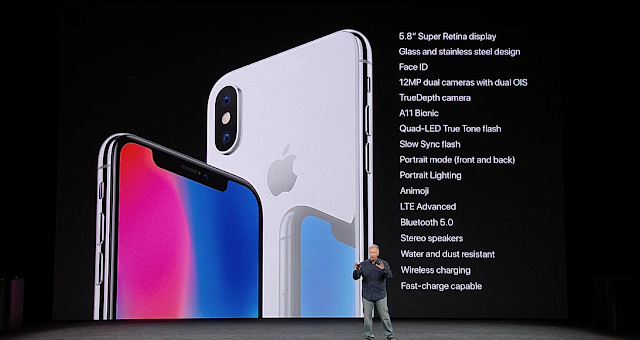How the iPhone X changes the way you use iOS
tech boster
October 28, 2021
How the iPhone X changes the way you use iOS
Apple expects to make a splash with the iPhone X unveiled this week. It represents "the future of the smartphone," according to Apple CEO Tim Cook, who expects it to set the path for smartphone technology for the next decade.</p><p>As such, it will also set the path for the way we use smartphones – or at least those from Apple – and that's going to mean a whole new set of gestures to learn, to include in training materials, and to allow for in app design and website interactions.</p><p>If your enterprise plans to provide staff with an iPhone X – or intends to support staff who use their own iPhone X for work – then here's what you need to know about the new gestures.
The Huge Display on the Iphone x
One of the most striking things about the iPhone X is its enormous display. At 5.8 inches, it's bigger than those on the iPhone 7 plus or 8 plus, although the iPhone X is smaller overall. </p><p>Apple didn't change the laws of physics to fit it in: It simply did away with the home button that has featured at the bottom of the screen on every other iPhone. </p><p>At the launch of the first iPhone in 2007, the home button served to wake the phone or return to a home screen full of app icons. Now it also manages multitasking, launches the Siri virtual assistant and unlocks the phone.</p><p>Several of the new gestures, then, are designed to compensate for that missing button.
How to wakeup on Iphone X
Before you can do anything with your iPhone X, you need to wake it up. Previously, that would have been done by pushing the home button – or raising the phone up.</p><p>The raise-to-wake gesture still works, but if you don't want to pick your phone up, you can now wake the iPhone X by tapping anywhere on the screen.</p><p>Anywhere? Yes, anywhere. If that kind of choice paralyses you, you can always just aim for the middle of the lower quarter, about where the home button used to be.
How to unlock an iPhone x
No home button means no fingerprint sensor, and no Touch ID, so if your iPhone X is locked, you have to pick it up and look at it. That's because the iPhone X authenticates faces, not fingerprints. Welcome to what Apple calls Face ID.</p><p>A package of LEDs and sensors at the top of the screen projects an invisible pattern of infrared dots, and records the position of their reflections. That allows it to create a 3D model of your face, and unlock the device when it detects the right shape in front of it.</p><p>Apple says there's a 1 in 50,000 chance that a random person could unlock your iPhone with their fingerprint. With Face ID, it says, the risk is one in a million
How to return to the home screen on an iPhone X
Now you're in, but you want to get back to the home screen. This used to take a single press on the now non-existent home button.</p><p>To return to the home screen on an iPhone X, touch the bottom edge of the screen and swipe upwards. The current app will shrink and then disappear to reveal the home screen. (If you're thinking that this gesture is already used for something else in iOS 10, don't worry: We'll get to that.
How to enter multitasking on an iPhone X
Entering multitasking used to require two pushes of the home button, so two swipes might have made sense. Instead, you'll have to swipe up from the bottom of the screen and then pause for a moment before letting go. The current app will shrink, instead of disappearing, then will be joined by other open apps on the left of the screen to form the familiar fanned-out deck of cards.
How to open the control center on an iPhone X
You've been patient: Now it's time to show you where the control center went. Previously, you opened it by swiping up from the bottom of the screen, but on an iPhone X, that simply returns you to the home screen.</p><p>To open the control center on an iPhone X, swipe down from the top right-hand corner of the screen, next to the central notch that conceals the cameras, speaker and other sensors.</p><p>Pressing and holding some of the functions in control center enlarges them, revealing additional options. For example, enlarging the play/pause audio control in the upper right makes room for an image of the album cover, controls for volume (and the ability to jump to any point in the track), and an Airplay button.
How to summon Siri on an iPhone X
Easy, right? A long press on the home but- oh, wait! That's right, no home button. And the swipe-with-a-pause-at-the-end gesture that might represent a long press is already used for multitasking. Don't worry, this one's easy.</p><p>To summon Siri on an iPhone X, make a long press on the lock button on the right-hand side of the phone. Or, of course, you can just say "Hey Siri."</p><p>On older phones up to the iPhone 5S and on the newer iPhone SE, which has the same form factor, the lock button was up top. That became difficult to reach one-handed on the larger phones Apple introduced with the iPhone 6, though, so it was moved down to the side. It stayed pretty small, though.</p><p>Now that Apple has bigger plans for the lock button, it's also made the button bigger.
How to open ApplePay on an iPhone X
Where were we? Ah yes, Apple's bigger plans for the lock button.</p><p>A short press to lock. A long press for Siri. What about pressing it twice, you say? You got it.</p><p>To open Apple Pay on an iPhone X, simply double-press the lock button on the side of the phone. To authorize payment, look at the phone while Face ID decides whether it's yours.
Review what you've learned
That's it: You're an iPhone X pro.</p><p>Now all you need to do is update your company's training materials to include the new gestures. </p><p>And while you're at it, why not review your company's apps and mobile website to make sure the gestures don't clash with existing functions? No one's going to like it if missing the control center by a millimeter, say, clears a form of its painstakingly entered data.
StatCounter
Search This Blog
Contact Form
contact form
Popular Posts

Sms Bomber v5 by Psycho
October 28, 2021
Statcounter
Random Posts
3/random/post-list
Most Popular

Design Tutorial Central 2021 - Technical Tutorials
October 28, 2021

Sketchy Wallpapers
October 28, 2021

Warning for 6 months Job Seeker Visa Holders
March 06, 2019
About Us
Privacy Policy
Copyright (c) 2021 Tech Here All Right Reseved
Menu Footer Widget
Crafted with by TemplatesYard | Distributed By Blogger Templates





